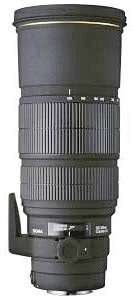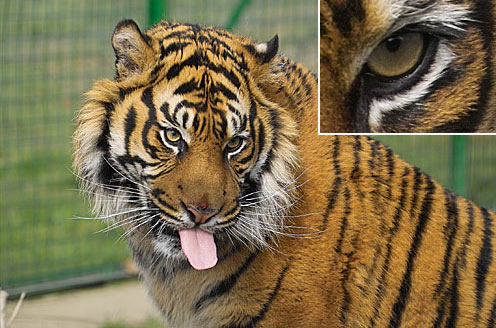Sigma 120-300mm f/2.8 EX APO IF HSM
 One of the most useful and popular telephoto zoom lens ranges is one that goes to 300mm focal length. Sigma’s latest 120-300mm is developed from the 300mm f/2.8 prime lens and offers a useful alternative for the sports photographer who would normally have a 70-200mm f/2.8 and a 300mm prime and work round the gap. This lens will adequately cover the shortfall. For the wildlife photographer who needs a longer range there’s also the optional dedicated 1.4x converter to give a 168-420mm f/4 or a 2x converter to extend the range to 240-600mm f/5.6. Both options still give full autofocus. Ian Andrews takes a look at the lens on a Sigma SD-10 to see if it’s an option you should be considering.
One of the most useful and popular telephoto zoom lens ranges is one that goes to 300mm focal length. Sigma’s latest 120-300mm is developed from the 300mm f/2.8 prime lens and offers a useful alternative for the sports photographer who would normally have a 70-200mm f/2.8 and a 300mm prime and work round the gap. This lens will adequately cover the shortfall. For the wildlife photographer who needs a longer range there’s also the optional dedicated 1.4x converter to give a 168-420mm f/4 or a 2x converter to extend the range to 240-600mm f/5.6. Both options still give full autofocus. Ian Andrews takes a look at the lens on a Sigma SD-10 to see if it’s an option you should be considering.
Sigma 120-300mm f/2.8 specifications
• Focal length 120-300mm
• Aperture f/2.8
• Angle of view 20.4 – 8.2 degrees
• Filter size / type 105mm
• Construction Elements/groups 18 elements in 16 groups
• Focusing type Internal HSM
• Closest focus 1.5m
• Weight 2.6kg
• Dimensions (Dia x length) 112.8x268.5mm
• Mounts available Canon, Nikon (D), Sigma, Pentax, Minolta
• Tripod bush Yes removable
• Price £1999.99
Build and Handling
From the moment you take this lens out of the box you realize the build and feel is excellent. Front and rear lens caps are provided along with a lens hood, a sturdy well-padded case and a warranty card that gives an extended three-year warranty from Sigma Imaging (UK).
It weighs in at a hefty 2.6kg, and at first this seems enormous, and in all honesty it is! Once a camera is attached though, it’s a well-balanced monster that is still possible to hand-hold for brief periods. A tripod collar is fitted. This is essential and, again, is top quality. It can easily be removed with a half turn of the good quality knob and a small pull to release the catch.
The zoom and focusing rings are well damped, almost to the extent of feeling stiff when new. They are both wide enough to get a good grip and there’s no looseness or movement. The lens does not change length when zooming or focusing with all adjustments happening internally. This is an excellent feature when using the lens on a beanbag as the focus ring does not turn during autofocus.
The lens hood, which is supplied attached in the reversed position, is a very solid metal affair. It’s a bayonet fit with an added locking screw slightly smaller, but matching the tripod collar screw. When fitted the right way round it makes a very effective shield and protector for the huge front element. The finish matches the rest of the lens and is hard wearing. This is a benefit if, like me, you use the lens hood braced against something solid for steadiness. The lens cap is a reinforced leatherette bucket style affair that fits well when the hood is reversed, but, annoyingly, will not stay put when the hood is in the useable position. This is caused by the knob that holds the hood in place stopping the Velcro tab from closing tightly.
The zoom ring is marked with a guide to the focal length with graduations marked at 120, 180, 200, 250 and 300mm. This is more than adequate to give a good idea of the length you are using. A window between the focus ring and the tripod mount ring gives a distance scale, but there is no depth-of-field indication. This is not a bad point as it would probably be difficult to incorporate with the internal workings and you will probably be buying this lens for its speed anyway!
The lens is fitted with Sigma’s HSM autofocus system (Hyper-Sonic Motor) and is quiet and responsive in use. Focusing speed is dependent on the camera that it is fitted to, but this lens is no slouch and gave us a pleasing performance. The system can be over-ridden by turning the focus ring to tweak an autofocused setting, or completely disabled (on Canon, Nikon and Sigma mounts) to leave full manual focusing by the movement of a small switch on the left side of the lens, adjacent to the mount. This switch is missing on the Nikon D mount. This switch is a positive click forward for Auto, back for Manual and, once you are familiar with the location, it’s easy to use. As the lens does not change physically in use, the fitting of polarizing filters is made easy, although at 105mm diameter, it is not cheap!
| Optical performance With modern computer-aided design and manufacturing practices, complete dogs are becoming rare, but as this lens is aimed at professionals and high-end amateurs we expect the very. In our tests we found the contrast throughout the zoom range is consistently good and it’s virtually as sharp wide open as it is stopped down two or three apertures. There’s no visible degrading at the edges, even on 35mm, although the majority of the time I shot on a cropped digital format where I would not expect the edges to be a problem anyway. This is the case for both sharpness and light fall-off (vignetting). Control of aberrations is excellent, helped no doubt by the inclusion of four SLD (Special Low Dispersion) elements, two in the front group and two in the rear. Halation and chromatic aberration are virtually impossible to induce and where they do show slightly is more likely a characteristic of the sensor as it is not evident on film. The only noticeable difference I can find is that the sharpness goes from great to stunning once the lens is stopped down from f/2.8 to f/4 or beyond! Although not normally a problem with longer focal length lenses, distortion, either barrel or pincushion, is not in evidence either. |
| |
Above: Sumatran tiger. 120mm 1/1000sec at f/4.5 ISO200 Sigma SD10 and 100% crop (inset).
Right: Armur leopard 300mm 1/400sec at f/4.5 ISO 400 on Sigma SD10.
Below: Mute Swans 600mm (300 + 2x) 1/1000sec at f/7.1 ISO200 on Sigma SD10
|
| |
 | ||
Check Sigma’s MTF data here.
The photos below are resized from the full frame test photos and the originals for each of these can be seen by clicking individually on each of the photos.
 | |
 |  Lens set at 300mm and f/2.8. |
Optional converter
Many photographers will consider this lens in conjunction with one of the optional dedicated converters supplied by Sigma. Although they can be used with other lenses in the Sigma range, (see compatibility chart) Sigma state that the converters are dedicated to this lens along with the APO 70-200mm EX HSM and the APO 300mm EX HSM. The 2x converter creates a reasonably priced alternative for a 600mm f/5.6 lens and is the combination we tried. Despite a couple of small niggles, we found the combination extremely usable. Despite the usual loss of two stops when the converter is fitted (only one stop with the 1.4x) the autofocus works almost as well as it does without, with just the occasional hunt. Picture quality suffers a little, but still produces results that are better than the budget APO 170-500mm zoom that I normally use.
We haven’t tested it yet, but the 1.4x should produce even better results.
My main niggle with this combination is a strange one. When carried with a monopod attached the lens occasionally unlocked itself from the converter, which could prove costly if the lens dropped off. This may well be down to a faulty catch on the converter, but, as a monopod is essential if using this combination while out wandering the countryside in search of wildlife subjects, this concerned me a little. I overcame it by leaving the tripod collar loose in order to relieve any pressure on the mount.
Verdict
Despite its bulk, which you learn to live with once you discover its capabilities, I found the lens a joy to use. With a professional weight camera fitted it’s very well balanced about the rigid mounting point and the mounting point is easily removed for use on a beanbag where it becomes a little obtrusive. The internal focusing and zoom means that the balance holds at all settings. The rig sits well on a monopod, which is where I would most expect to find one. The most annoying point when using the lens, is the front cap’s inability to stay put when the hood is in the use position. Point the camera downwards and you will be bending to pick up the cap! That said, I love the rigidity of the hood, which gave confidence when putting the rig down to rest your arms.
In summary the main positive points of the Sigma 120-300mm f/2.8 are:
![]() Picture quality
Picture quality
![]() Internal mechanisms
Internal mechanisms
![]() Build quality
Build quality
![]() Versatility
Versatility
![]() Hood
Hood
Negative points are:
![]() Weight
Weight
![]() Lens cap
Lens cap
Check latest price here
Test by Ian Andrews
www.wildaboutkent.co.uk
i would like to know how this lens compares to the Nikon AF-S VR-Nikkor 70-200mm f/2.8 G (IF)
Add your message
Please login here or if you've not registered, you can register here. Registering is safe, quick and free.
photodo Stats
428 MTF tests
74 in-depth photodo reviews
100+ users join each day
Help the lens community by reviewing or rating a lens today via our lens search
Latest Lens Reviews
- Chinon 28mm f/2.8 Vintage Lens Review
- Canon EF 70-200mm f/4L IS II USM Lens Review
- Samyang AF 85mm f/1.4 EF Review
- Sigma 70mm f/2.8 DG Macro Art Review
- Samyang AF 24mm f/2.8 FE Review
- Meike 50mm f/1.7 Review
- Tamron 70-210mm f/4 Di VC USD Review
- Lensbaby Burnside 35mm f/2.8 Review
- Asahi Super Takumar 50mm f/1.4 Review
- Asahi Super-Multi-Coated Takumar 135mm f/3.5 Review



